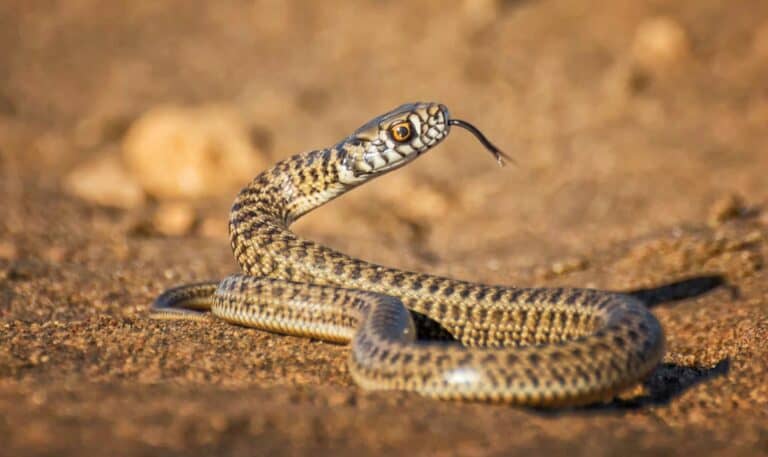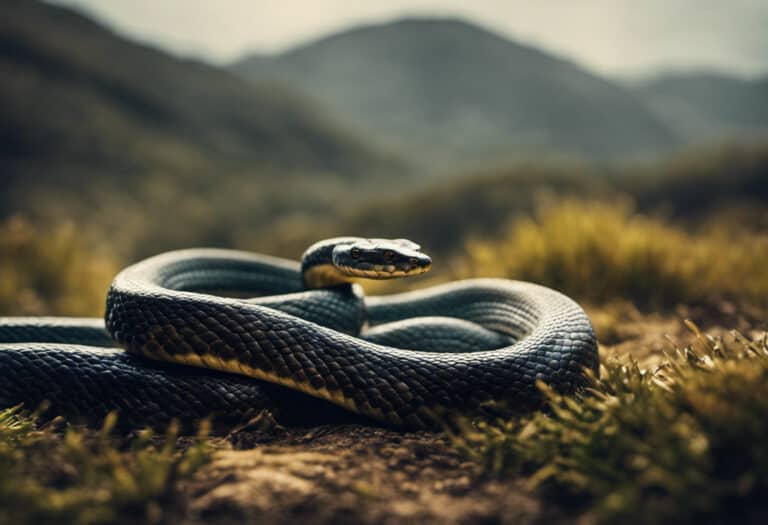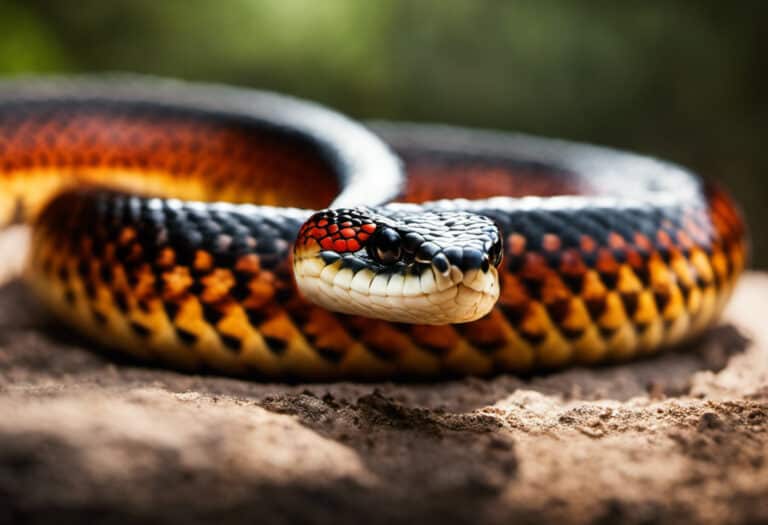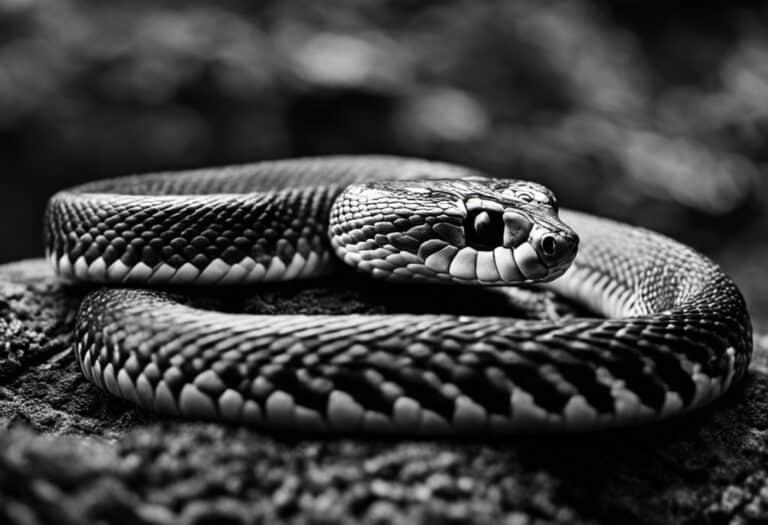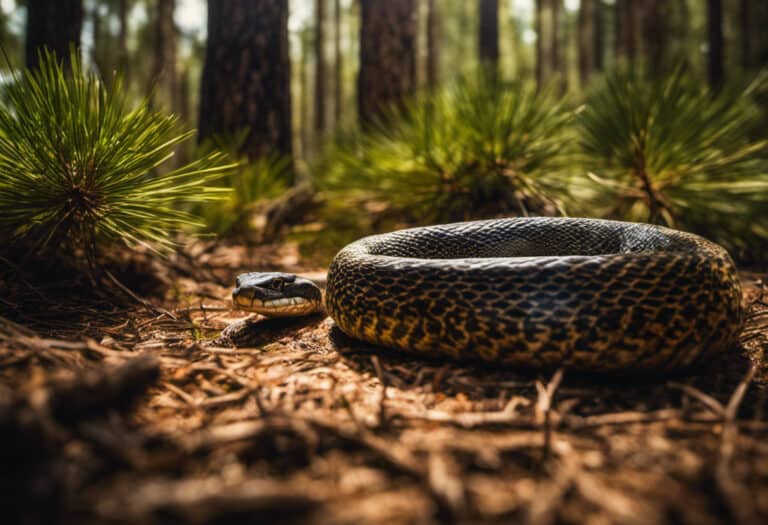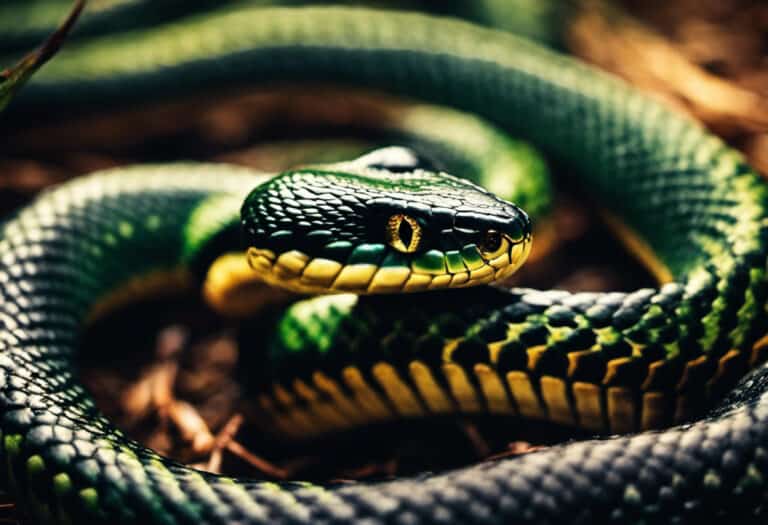Are Rough Green Snakes Venomous
Curious about the venomous nature of rough green snakes? Look no further! You’ll be relieved to know that these slender, bright green creatures do not possess venom.
Despite their intimidating appearance, they rely on their excellent vision and hunting techniques to capture prey. With their rough scales and well-camouflaged bodies, these snakes blend easily into leafy tree habitats, making them difficult to spot.
Join us as we debunk the myths surrounding rough green snakes and shed light on their fascinating reproductive and life cycle.
Key Takeaways
- Rough green snakes do not possess venom and are therefore harmless to humans.
- They rely on defense mechanisms other than venom to protect themselves.
- Their lack of venom does not make them vulnerable, as they have effective strategies such as camouflage and rapid movements to disorient predators.
- The non-venomous status of rough green snakes contributes to the freedom and harmony they symbolize in their natural habitat.
Physical Characteristics of Rough Green Snakes
The rough green snake has a long, slender, bright green body with rough-looking scales. These scales give it a distinctive rough texture, which is where it gets its name. It grows to be about 22 to 32 inches long and has a white, cream, or yellow belly.
This species is well-camouflaged in dense vegetation, making it difficult to spot. When it comes to courtship rituals, males use various behaviors such as chin rubbing, tail waving, and head jerking to court females. Females reach sexual maturity at around 21 to 33 months and will lay two to 12 eggs in June or July.
These eggs are typically laid in a moist location, such as a tree hollow or under a rock. It isn’t uncommon for several females to share a nest.
Diet and Feeding Habits of Rough Green Snakes
You can find a variety of insects, snails, spiders, and small frogs in the diet of the rough green snake. These fascinating creatures have developed feeding adaptations and hunting strategies that allow them to thrive in their natural habitat. Here are some key points to consider:
-
Feeding adaptations:
-
Excellent vision: The rough green snake relies on its sharp eyesight to locate and track down prey.
-
Spring-like curves: When within striking range, the snake assumes a coiled position, ready to propel its head forward.
-
Body propulsion: To catch its prey, the snake straightens out its entire body, propelling its head towards the target.
-
Hunting strategies:
-
Insect-focused diet: The snake primarily feeds on insects such as crickets, caterpillars, and grasshoppers.
-
Diverse prey: In addition to insects, the rough green snake also consumes snails, spiders, and small frogs.
These feeding adaptations and hunting strategies allow the rough green snake to successfully capture and consume its prey, ensuring its survival in its natural environment.
Natural Predators of Rough Green Snakes
Birds, larger snakes, domestic cats, and some large spiders are natural predators of the rough green snake. These predators pose a threat to the survival of this species, as they rely on the rough green snake as a source of food.
The rough green snake, known for its vibrant green color and rough scales, is relatively defenseless and doesn’t bite. Instead, it relies on its excellent camouflage in dense vegetation to hide from predators.
When it comes to courtship rituals, male rough green snakes use chin rubbing, tail waving, and head jerking to court females. Females reach sexual maturity at 21 to 33 months and lay two to 12 eggs in June or July.
These eggs are typically laid in a moist location, such as a tree hollow or under a rock. It isn’t uncommon for several females to share a nest, making nesting preferences a crucial aspect of their reproductive cycle.
Reproduction and Life Cycle of Rough Green Snakes
Now let’s explore the reproduction and life cycle of rough green snakes.
These fascinating creatures engage in courtship behaviors such as chin rubbing, tail waving, and head jerking to attract mates.
Females reach sexual maturity at 21 to 33 months and lay two to 12 eggs in June or July, typically in a moist location like a tree hollow or under a rock.
It’s interesting to note that several females may share a nest, highlighting the unique group nesting dynamics of these snakes.
Courtship Behaviors Observed
During courtship, males display chin rubbing, tail waving, and head jerking behaviors to attract females. These courtship displays are observed during the breeding season, when males are actively seeking a mate.
The chin rubbing behavior involves the male rubbing his chin on objects in his environment, leaving behind scent marks that serve as a signal to females. Tail waving is another prominent behavior, where the male waves his tail in a rhythmic motion, possibly to capture the female’s attention.
Head jerking is also observed, where the male rapidly moves his head back and forth, potentially signaling his fitness and readiness to mate. These courtship behaviors are crucial in the reproductive success of rough green snakes, as they allow males to attract females and initiate the breeding process.
Egg-Laying Locations Preferred
You’ll find that rough green snakes prefer to lay their eggs in moist locations such as tree hollows or under rocks. This egg-laying behavior is influenced by their need for a suitable environment to ensure the survival of their offspring.
The choice of a moist location helps to maintain the necessary humidity levels for the eggs to develop properly. Additionally, laying eggs in tree hollows or under rocks provides protection from potential predators.
Interestingly, rough green snakes also exhibit nest sharing dynamics, where several females may share a nest. This behavior may serve as a form of communal defense, as multiple females guarding the nest can better deter predators.
Group Nesting Dynamics Common?
Did you know that group nesting dynamics are common among rough green snakes? These fascinating creatures have unique courtship rituals and social behaviors that contribute to their survival.
Here are some interesting facts about their group nesting dynamics:
- Rough green snakes often share nests with several females, creating a cooperative living arrangement.
- Group nesting helps provide protection and security for the eggs, as multiple females can defend the nest against predators.
- This behavior also allows for communal thermoregulation, with the snakes huddling together to maintain optimal temperature for egg development.
- Group nesting dynamics may also facilitate information sharing among females, such as identifying suitable egg-laying locations or sharing food sources.
- It’s believed that these group nesting dynamics are a result of the snakes’ social nature and their need for increased reproductive success.
These group nesting dynamics highlight the complexity and adaptability of rough green snakes, showcasing their ability to work together for the greater good.
Venomous or Non-Venomous: Debunking the Myth
Contrary to popular belief, rough green snakes are non-venomous and pose no threat to humans. These slender creatures, with their distinctive rough scales and bright green bodies, rely on their camouflage strategies to blend in seamlessly with their leafy surroundings.
During courtship rituals, males use chin rubbing, tail waving, and head jerking to attract females. Once mating occurs, females lay two to 12 eggs in a moist location, such as a tree hollow or under a rock. It isn’t uncommon for several females to share a nest.
The eggs hatch in about six weeks, and the young snakes start their lives as independent predators, feeding primarily on insects. With their non-venomous nature and fascinating courtship rituals, rough green snakes are a symbol of freedom and harmony in their natural habitat.
Understanding the Defense Mechanisms of Rough Green Snakes
Now let’s delve into the fascinating world of the defense mechanisms employed by rough green snakes. Despite being non-venomous, these snakes have evolved a variety of strategies to protect themselves from predators.
Here are the key defense mechanisms of rough green snakes:
-
Camouflage: Rough green snakes are masters of disguise, blending seamlessly with their leafy surroundings. Their bright green coloration and rough scales help them blend into the dense vegetation, making it difficult for predators to spot them.
-
Flight response: When threatened, rough green snakes often resort to fleeing rather than fighting. They’re incredibly agile climbers and can quickly escape into the safety of the trees or shrubs, where their slender bodies allow them to maneuver with ease.
-
Rapid movements: When cornered, rough green snakes will engage in rapid, jerky movements to startle and confuse predators. This sudden burst of motion can be disorienting, giving the snake an opportunity to escape.
-
Defensive postures: In some cases, rough green snakes may assume defensive postures to deter predators. They may flatten their bodies and open their mouths wide, hoping to appear larger and more intimidating.
-
Tail autotomy: As a last resort, rough green snakes have the ability to shed their tails if grasped by a predator. This ‘tail autotomy’ allows them to break free and escape while the predator is left with just the detached tail.
Understanding these defense mechanisms not only highlights the resourcefulness of rough green snakes, but also showcases their ability to survive and thrive in their natural habitat, free from the need for venomous protection.
Frequently Asked Questions
How Can Rough Green Snakes Defend Themselves if They Are Non-Venomous and Lack Defensive Mechanisms?
Rough Green Snakes are non-venomous and lack defensive mechanisms. However, they rely on their excellent camouflage in dense vegetation to hide from predators. This helps them evade threats and survive in their environment.
Can Rough Green Snakes Lay Their Eggs in Any Location, or Do They Have Specific Preferences?
Rough green snakes have specific preferences when it comes to laying their eggs. They typically choose moist locations like tree hollows or under rocks. This ensures the eggs have the right conditions for development.
Do Rough Green Snakes Have Any Unique Behaviors During Courtship and Mating?
During courtship and mating, rough green snakes exhibit unique behaviors such as chin rubbing, tail waving, and head jerking. These rituals are used by males to court females and establish reproductive connections.
Are Rough Green Snakes More Commonly Found in Maryland or Virginia’s Coastal Plain?
Rough green snakes are commonly found in the coastal plain of Maryland and Virginia. They prefer habitats with leafy trees, shrubs, and vines near water. Their population distribution is influenced by these habitat preferences.
Are Rough Green Snakes More Active During the Day or at Night?
During the day, rough green snakes are more active. This is influenced by factors such as temperature, prey availability, and predation risk. They rely on their excellent vision to find and track down prey.
Conclusion
In conclusion, despite their intimidating appearance, rough green snakes are non-venomous creatures that rely on their hunting techniques and excellent vision to capture their prey. They primarily feed on insects, snails, spiders, and small frogs.
One fascinating statistic is that rough green snakes can consume up to 10 insects per day, making them efficient predators in their leafy tree habitats.
Understanding the truth behind the myth of their venomous nature allows us to appreciate the unique characteristics and important role these snakes play in their ecosystem.
